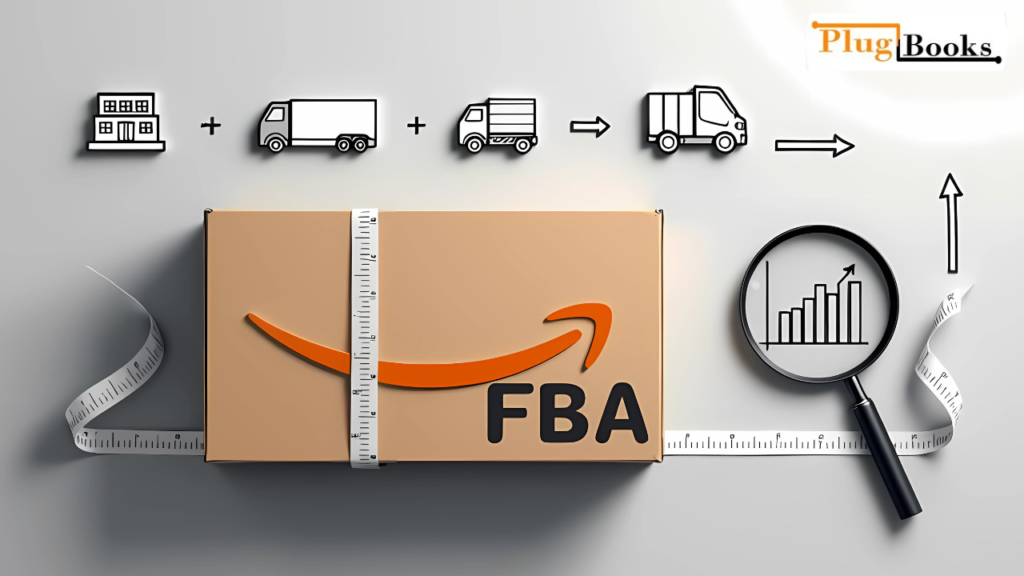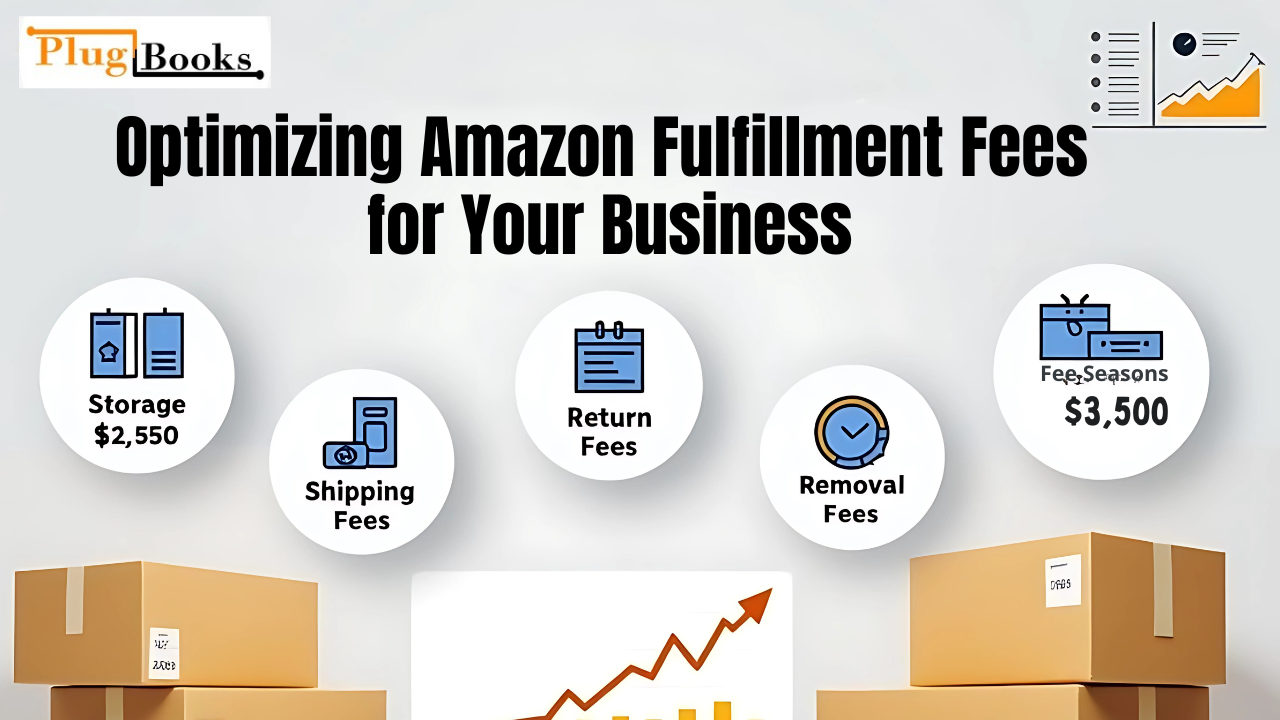Though Fulfillment by Amazon (FBA) comes with its costs, it can significantly help expand your business by enabling you to sell on one of the world’s largest e-commerce platforms. These costs are known as amazon fulfillment fees and understanding them is essential for maximizing your profits.
If you want to succeed, it’s crucial to keep up with the latest changes to Amazon’s fulfillment fee structures. In this comprehensive guide, we’ll dive into how the updates to fees of Amazon fulfillment impact your bottom line and what you need to know to navigate them effectively.
Keynotes
- Whether their company is large or small, Amazon fulfillment fees impact all FBA sellers.
- Amazon’s fulfilment fee rates rise in busy times.
- Avoiding penalties depends on knowing the age of your merchandise.
- Optimise your items’ packaging and size to help to lower costs.
- Tracking and fee forecasting can be automated using Plugbooks.io.
What Are Amazon Fulfillment Fees?
Amazon charges you to pick up, pack, ship, and assist consumers with your products Amazon fulfilment fees. When you ship your goods to Amazon’s fulfillment facilities, they handle everything; it doesn’t come free.
The fee of Amazon fulfillment typically includes:
- Usually, Amazon’s fulfillment costs cover picking up and packing goods.
- Getting it to the client
- tending to customer service and returns
- Maintaining goods at Amazon’s outlets
You must be current with Amazon’s fulfilment fee rates if you want to remain competitive in 2025. The weight, kind of the product, and size all affect these rates.
Breakdown of Amazon Fulfillment Fees 2025
Understanding the components of Amazon fulfillment expenses can enable you to decide on marketing, price, and product mix more wisely.
This is the complete list:
| Component | Details |
| Fulfillment Fee Per Unit | Charged based on size and weight. |
| Monthly Storage Fee | Pay to store inventory in Amazon warehouses. |
| Aged Inventory Surcharge | Higher fees for stock stored beyond 180 days. |
| Returns Processing Fee | Fees for returned products in certain categories. |
| Removal/Disposal Fee | Costs for removing or disposing of unsold inventory. |
Each Amazon fulfillment cost can influence your margins, especially during peak seasons.
Fulfillment Fee Amazon Updates You Must Know (2025)
Big changes to fulfillment fee Amazon pricing went into effect in 2025, including:
- Higher standard-size product fees: They start at $3.22 per unit.
- Peak season surcharges: Additional charges apply from October to January.
- Aged inventory surcharges: Old items now have surcharges following 180 days rather than 365 days.
- Storage utilization surcharge: For sellers with too much inventory, there is a new tax called storage utilisation surcharge.
Should your strategy fail to include these Amazon shipping costs, you could lose money.
Every change in Amazon’s fulfillment fees is tracked by Plugbooks.io so that consumers are always current.
How Amazon Calculates Your Amazon Fulfillment Fees
Understanding how Amazon fulfillment costs are calculated will save you money.
Here are the main factors:
- Size tier: Standard sizes include small, big, and extra-large.
- Shipping weight: More money follows from more weight.
- Dimensional weight: For very large but non-heavy items.
- Category-specific rules: Including garments, have varied rates of charge.
Although Amazon bases fulfillment fees on complex calculations, merchants should know them to prevent expensive shocks.
Example:
Depending on how heavy or huge the item is, Amazon fulfillment cost can double or even triple if you sell a little paperback book instead of a large blanket.

Hidden Costs Behind Amazon Fulfillment Fees
Beyond regular per-unit Amazon fulfillment costs, there are hidden costs:
- Long-term maintenance expenses for non-fast moving objects
- Managing taxes on returns of items like clothing
- Charges for using too much space for your products’ storage
- Fees for relocating items if sold and for disposal of commodities
Many sellers ignore these hidden Amazon fulfilment cost elements until it is too late.
Using a solution like Plugbooks.io will enable you to monitor them closely and identify issues early.
Tips to Minimize Your Amazon Fulfillment Fee
Want to lower your Amazon fulfillment costs? Here’s how:
1. Optimize Your Product Size
Smaller products ship for less cost. Reducing a few millimetres off boxes can save a lot of money.
2. Increase Sell-Through Rates
Faster sales of your products can help you to save storage costs and raise your selling statistics.
3. Forecast Inventory Better
To save paying fees for outdated items, get ahead of sales highs and lows.
4. Use Bundles
More goods can be moved using bundles, which helps Amazon maximise the fulfilment fee it charges each sale.
5. Monitor Fee Changes
Amazon adjusts its prices annually. The alerts on Plugbooks.io will inform you of any adjustments to Amazon’s fulfilment fees.
Why Tracking Fulfillment Fee Amazon Trends Is Critical
Every year, fulfillment costs of Amazon trends change and sellers who don’t adapt lose out.
In 2025, higher storage and peak season fees mean sellers must:
- Rapidly alter the item pricing.
- Get rid of old inventory more quickly.
- You can exactly forecast Christmas supply.
- Charge fees to the margin estimations.
Ignoring Amazon fulfillment cost is no longer a choice; these days, any FBA strategy must include these costs. Your gains won’t vanish out of nowhere if you monitor your Amazon fulfilment fee statistics using Plugbooks.io.

How Plugbooks.io Helps You Manage Amazon Fulfillment Fees
One excellent tool for understanding the convoluted world of Amazon fulfillment cost is Plugbooks.io, which aids Amazon buyers. Working with QuickBooks makes it simple for Plugbooks.io to track all of your fulfillment fees from storage and shipment to returns and disposal. This strong link ensures that you never miss a charge adjustment or unknown cost since it lets you maintain a whole record of all the expenses linked to Amazon FBA.
Plugbooks.io allows you to clearly view the profit margins of your company, create precise financial reports, and project expenses. This helps you to make decisions for your Amazon store grounded in evidence and ensure continuous growth of it.
Conclusion
Salespeople will have to know Amazon fulfillment costs if they are to be successful in 2025 and beyond; they cannot now grasp them. Ignoring how Amazon’s fulfillment fees are set will quickly cause you to lose money. These Amazon prices cover extra for busy periods of year as well as monthly storage costs.
Every dollar you save directly affects your bottom line given Amazon’s revised fulfilment fee rates and increased competitiveness in other areas. Those who keep current, ensure their product dimensions are ideal, and properly project their inventory needs will have a great advantage.
Using automated financial monitoring systems like Plugbooks.io helps you better control your fulfillment expenses, prevent surprises, and feel more confidence in your company decisions. Beginning now, you may maximise your Amazon fulfilment fees and create a long-term FBA business for 2025’s expansion.
Disclaimer
This blog article is only for your knowledge; it is not intended to be business, legal, or financial advice. For official fee schedules and most current news, always visit Amazon Seller Central. Not in any sense connected to Amazon is Plugbooks.io.





One thought on “Optimizing Amazon Fulfillment Fees for Your Business”